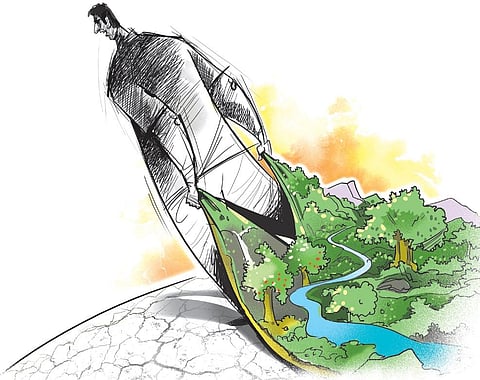

For Karnataka, 2023 was like different shades of the forest — glowing in the sun with the tiger census report, rumbling with pride with the elephant census report, while being filled with shades of grey, recording a rise in man-animal conflicts that saw several deaths.
Just ahead of the assembly polls, Prime Minister Narendra Modi released the all-India tiger census report in July in Mysuru, which showed Karnataka continuing to retain its second position, housing 563 tigers. The PM went on a safari at Bandipur Tiger Reserve. The location was important as it was among the first nine tiger reserves declared in India. The event was also important as it marked 50 years of Project Tiger.
Subsequently, in August, the all-South India elephant census report was released and the state retained its No. 1 position, with 6,395 pachyderms. The assessment was important as Karnataka had taken the lead in taking up the census along with the Indian Institute of Science (IISc).
As the state’s back was patted emphatically because of the rising numbers, slips in management too came to light. Elephant electrocutions rose, while instances of tiger and leopard conflicts with humans were no less.
According to department officials, over 70 leopards and three tigers were captured this year. The government faced strong criticism over the death of famous tusker Arjuna, the Golden Howdah-carrying elephant of Mysuru Dasara. He died in conflict with a wild bull in Hassan during a radio-collaring operation in December.
Another incident that stressed more attention towards managing buffer zones and wild animal capture operations was the shooting of a wild leopard in AECS Layout, Bengaluru, in November. The death of forest department’s tranquilising expert Venkatesh in Hassan, also raised eyebrows.
To mitigate conflicts, the government announced an elephant task force in districts that are prone to such incidents. Forest, Environment and Ecology Minister Eshwar Khandre has admitted that conflicts have gone up with the increasing wildlife population. Forest department officials admitted that the carrying capacity of forests and buffer zones had shrunk as encroachments had increased.
Experts said the government was unable to protect its forest cover and create elephant corridors, which led to a rise in conflicts. They pointed to the state government’s plan to take over deemed forests, which otherwise act as buffers. Instead of looking at them as revenue patches for real estate, they should be seen as pockets for carbon sequestration, the experts suggested.
Experts recalled that though the government announced tribal relocation, nothing was done on the ground. Instead, the government made efforts to hamper Cauvery Wildlife Sanctuary — a prime elephant corridor, to take up the Mekedatu reservoir project, over which the government drew flak with Deputy Chief Minister DK Shivakumar making a presentation before Union Finance Minister Nirmala Sitharaman, seeking funds, without field surveys or public consultations.
MIXED BAG